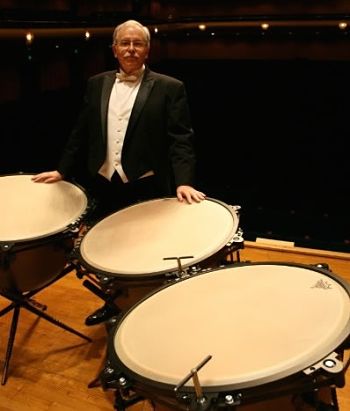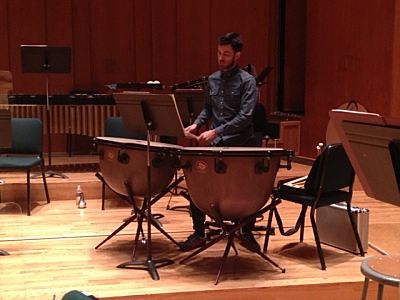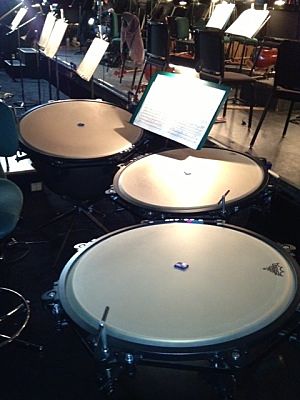
Sunrise, Green Lake, Interlochen MI
10-11-14
Like it’s name implies, Interlochen is situated between two lakes. Except for our Mighty Eight Orchestra Road Trip, which begins later this month, this will be our home through November. It’s a beautiful place to be with so many trees and so much color. The school has produced famous artists, authors, dancers, actors and musicians, including Utah Symphony’s own Caitlyn Valovick-Moore, James Hall, John Eckstein and my classmate, Scott Lewis. Since Scott and I graduated, the school has added Creative Writing, Comparative Arts, Film and Song-Writing to it’s curriculum. The campus has excellent facilities and an enrollment of about 500 students. With a tuition of $54,000, scholarships must be generous, or the families sending their child to this school, rich. Most of those students were on display last night, as we went to see and hear the Collage concert in Corson Hall. The hall seats close to 1000 people and every seat was taken. All the seating is on one floor, but the tiers along the side offer antiphonal opportunities which were amply realized last night. The short-but-sweet performances went uninterrupted for about 90 minutes. There were dance (modern and classical) segments, percussion ensembles, a flute choir, a clarinet quartet, a student film, a band, a string quartet, songs, a jazz band, creative writing readings, choirs, a harp ensemble, piano solos, nine bassoons playing “Mars” from The Planets, a scene from “Into the Woods”, a brass quintet, a trombone quartet and the orchestra playing Copland’s “Hoe-Down”. Though the announcement to hold your applause until the end was made before the concert, it was a challenge to do so. We left feeling inspired by the energy and fearlessness of the students. It all gave me a good idea of what to expect when I conduct a master class with the oboes and judge the concerto competition next month. Today I should see Dan Stolper, the oboe instructor at Interlochen for the last 43 years! He has students in orchestras all over the world, so I’m eager to learn his secrets. As we might have been able to forecast, we think we’re seeing music and the arts from a different perspective and perhaps with a greater appreciation. Like our beautiful surroundings, there is lot yet undiscovered.

Catherine Valovick, Lisa and Bob
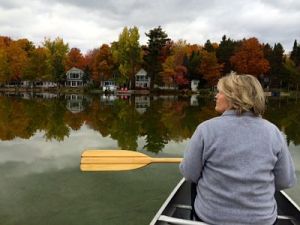
Lisa in quiet reflection
10-23-14

Shopping at Flute World, Farmington Hills, MI
The color season in northern Michigan reached it’s peak during the past couple weeks. We loved taking pictures of all the red, yellow, gold and orange trees. The homeowners along the shores of Green Lake began bringing in their boats, docks, lawn furniture, etc. for the upcoming winter. A lot of raking and the installing of shutters have occupied people’s time. The Farmer’s Almanac, the U.S Weather Service and the dozens of squirrels hoarding food, give us an idea another “polar vortex” could be on it’s way. We bundled up for a couple of canoe trips on the lake before packing it into the boathouse for the next seven months.We took time out from our various projects to make a trip to Frankfurt for dinner and a recital featuring a flute and guitar duo. It was our great fortune to hear Jeffery Zook and Bret Hoag. Jeff plays flute and piccolo with the Detroit Symphony. He and Bret have been performing together for many years and their ensemble playing proved it. The recital took place at an impressive art gallery with some excellent art, primarily paintings by Michigan artists. Debra Fayroian was the director of the chamber music series. She and her husband Wes Jacobs are former members of the Detroit Symphony and both were especially entertaining. Jeff and Bret’s recital was varied and colorful. Jeff played on four different instruments, including an alto flute and a B-flat flute. His playing was beautiful and convincing. We had the feeling he was experienced and comfortable with his audience. Afterwards, we all went out to a local brew pub. We discussed coming to hear the Detroit Symphony in February. Maybe something with a lot of piccolo? The Traverse Symphony Orchestra conducted by Kevin Rhodes appeared at Interlochen to a sold-out audience. Their soloist in the Berg violin concerto was an Interlochen graduate, Caroline Goulding. She gave an excellent performance of a difficult concerto, and Mr. Rhodes’ preconcert lecture helped the listeners appreciate the music. The orchestra gave a spirited performance of Beethoven’s 5th for the second half. It appeared that there was good communication between Mr. Rhodes and his players. The audience left happy. Our fifteen-day road trip started in Detroit and St. Claire Shores. We spent time and money at Flute World in Farmington Hills before arriving in St. Claire Shores. Our hosts were friends Carolyn and Mike Florin, long-time residents of St. Claire Shores. Their beautiful home close to Lake St. Claire was filled with charm and family memories. We enjoyed seafood dinners before heading off to see the opera “Elektra” by Strauss. The performance featured the Michigan Opera Theatre in the historic Detroit Opera House and soprano Christine Goerke in the title role. The imposing tower and slabs of granite-looking debris set the scene. For almost two hours, Ms. Goerke transfixed her audience. The orchestra was secure and dynamic. Having never seen or played “Elektra”, I was struck by the music. When you’ve played pieces like Don Juan, Ein Heldenleben, Don Quixote, Till, the Strauss Oboe Concerto, etc. for so long and loved them all, the sound of that unique Strauss voice made a huge impression. The opera is intense and exhausting to perform, but the voices were strong and convincing. The audience had been on a journey.For us, the next journey….Severance Hall, Cleveland, Ohio.
10-28-14
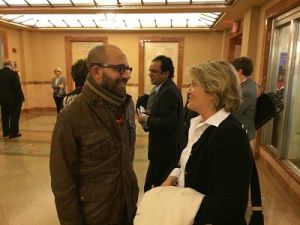
Joshua Smith with Lisa

Robert Walters, Lisa and Bob
We made it from Detroit to Cleveland in time to meet another Utah Symphony alum, David Brockett and his wife, Dini, for an excellent dinner at Lopez in Cleveland Heights. The restaurant was opened by Rick Bayless of TV’s ‘One Plate at a Time’ fame. Dave is playing, teaching horn and going back to school through the Cleveland Clinic. He should someday have a ‘Dr.’ in front of his name. Our connection goes back to the Blossom Music Festival and all before my audition with the Utah Symphony. Dini has a fascinating job working as a music, dance and art collaborator with young people in Cleveland. The food was good. The concert at Severance Hall was suppose to feature Hilary Hahn, but a wrist injury prevented her from appearing. Instead, we were treated to the Bach Cantata No. 199. The cantata featured soprano, Yulia Van Doren, who sang beautifully, but it was oboist, Frank Rosenwein, who stole the show. Frank’s playing was smooth and effortless, controlled, but sparkling. As an oboe player, you couldn’t help but notice how at ease he seemed singing through such a challenging piece. Former Utah Symphony concertmaster, Bill Prueucil, led the strings with all his 35 years of experience. The hall was beautiful, though there were many empty seats. The Brahms ‘Song of Destiny’ concluded the first half. Guest conductor, James Gaffigan, conducted the evenings works. He brought about the most gorgeous sound from the chorus. It was rich and balanced. Joshua Smith, playing on a wooden flute, was one of the highlights. Mendelssohn’s 5th Symphony finished the program. The orchestra’s playing was clean and refined. Lisa got to see Josh Smith after the performance and they enjoyed remembering their time together as students at Curtis. The next morning we were able to meet Robert Walters for breakfast in Shaker Heights. Robert plays English horn in the Cleveland Orchestra and teaches oboe at Oberlin. He admitted that playing English horn in a four-person section gave him time for both jobs. Lisa and Robert were classmates in Philadelphia. Robert had spent time in Utah and told a really funny story about climbing Mount Olympus. He somehow survived being stuck between a cliff and a rattlesnake. Maybe it wouldn’t have been so funny if the cliff or the snake had altered his survival. Lisa mentioned that we had been to Flute World in Michigan. Robert suggested that maybe it was some kind of amusement park, so we imagined all the different ways an enormous flute could serve as a tubular ride. We could understand why he has also been a successful poet in his colorful career.

Scott Bell, Harold Smoliar, Henry Ward, Bob Stephenson and Cynthia DeAlmeida
The ride to Pittsburgh didn’t take too long. The major cities all seem closely situated compared to the wide open spaces of the west. The scenery featured mile after mile of rolling hills. Quite suddenly the Pittsburgh sky-line came into view. With all the rivers, Pittsburgh has more bridges than you can count on two hands. With Google Map’s help we made it successfully to Harold Smoliar’s house. Harold and I know each other from both Interlochen and Curtis. He has played English horn in Pittsburgh for more than three decades, surviving multiple music directors, forming his own jazz combo and raising twins. Like Robert Walters, Harold would be off for the night. We went out for Italian and then heard the Pittsburgh Symphony play three works. Harold found seats for us that were centrally located but back in the second tier, the “best seats in the house”. The Suite from Peer Gynt opened the concert. Yan Pascal Tortellier conducted. Newcomer Henry Ward played the first oboe part and distinguished himself admirably. The acoustics were really good and the orchestra seemed to notch up the energy level. It was great to see and hear former Utah Symphony brass players, Steve Kostyniak and Murray Crewe, assume their starring roles. Both would get solo bows before the night was done. Lorna McGhee played the solo flute part in Nielsen’s Flute Concerto. It didn’t take long to see why she’s regarded as one of the country’s greatest flute players. Her playing had personality, color and execution. Her resonant tone projected in the softest dynamic and the most thrilling forte. The huge bouquet of flowers brought out for her afterwards were well deserved and her colleagues joined in the long-lasting applause. We met still another Utah Symphony alumnus, Jim Nova, at the concert’s intermission. Jim looks the same and seems very happy. Many of us remember his wife, Lindsay, who worked in the administration of the Utah Symphony. The Sibelius Symphony No. 5 finished the program. The orchestra’s playing was passionate, energized and expansive. A large cast joined the group, increasing the level of excitement. There were so many stars contributing, my report would go on for ever. At least a dozen, mostly musicians, went to a restaurant following the concert. My student, Brooke King, from the Sewanee Music Festival and now studying with Cynthia Koledo DeAlmeida and an old friend of Lisa’s, Jennifer Ann Steele, also came for the celebration. It was loud and fun.
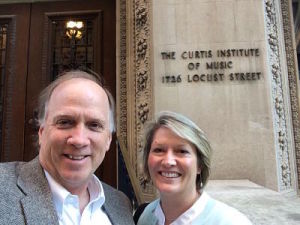
Bob and Lisa at their alma mater
We drove to Philadelphia for the next part of our orchestra tour (without instruments). As we had both been students in Philadelphia, it was a time of true nostalgia. We spent time walking the familiar halls of the Curtis Institute of Music and even interrupted a horn duo so I could see the Tabuteau Room. Tabuteau was my musical grandfather and though we never met, his influence looms large. We had dinner with Jeff Kirschen, another Utah Symphony alumnus, and then would meet my classmate, David Cramer after the concert. The city has a new energy, more restaurants, cleaner streets and somehow those streets seemed less wide than our memories. The arts district is bigger and the new home for the Philadelphia Orchestra is the Kimmel Arts Center. It’s big and our seats took a while to reach. The players photos line the walls where the audience members congregate. Our seats were high up and the curving architecture made it impossible to see the majority of the orchestra! We had to lean over the railing to see who was playing. It seemed dangerous. We would switch seats before the night was through. A piece by Julian Anderson, ‘The Stations of the Sun’, opened the concert. Vladimir Jurowski conducted. The work was atmospheric and complex. The Mozart Violin Concerto No. 4 with Alina Ibragimova as soloist came next. Ms. Ibragimova was especially exciting to hear. Her playing was very clean and stylistic. ‘Also Sprach Zarathustra’ followed intermission. This was a piece that the Philadelphia Orchestra owns. The mass of players and extras make a collective sound that is almost overwhelming. I was especially impressed with the brass, the strings, the woodwinds and the percussion. Oh, that’s everybody! Once again, we got to see another former Utah Symphony musician, Shelley Showers, adding her brilliance to the horn section along with Jeff Kirschen. We stayed the night on the third floor of a house in Germantown, courtesy of AirBnB.
We were up early to get to Baltimore and the home of Jane Marvine and Jim Olin, classmates at Interlochen and members of the Baltimore Symphony. Jane made a great brunch. Jim is recovering from eye surgery. Their house is beautiful. The lots where Jane and Jim live are big and giant trees are everywhere. Jane is especially busy playing oboe and English horn and spear-heading various programs that help the Baltimore Symphony. Orchestras from far and wide have approached her about the work with amateurs that the Baltimore Symphony has utilized over the past ten years. We drove to Strathmore for a Sunday afternoon concert. Marin Alsop conducted Christopher Rouse’s ‘Rapture’, Scriabin’s ‘Poem of Ecstasy’ and ‘Ein Heldenleben’ by Strauss. The Baltimore Symphony is a very good orchestra with many stars. Ms. Alsop conducts with fluid clarity and obvious energy. It was wonderful to hear Jane play for the first time since our high school days, along with one of my favorites, Katherine Needleman, Michael Lisicky and brand-spanking-new Melissa Hooper, another Interlochen graduate. The repertoire gave ample opportunity for the concertmaster, the first horn and the first trumpet to shine. Andrew Balio, on trumpet, was someone Lisa knew from a summer at Tanglewood, along with Tony DiLorenzo and a young singer/piano-man named Harry Connick, Jr. Two things about our trip are holding true; there are some fabulous orchestras out there and ……it’s a small world.
– Robert Stephenson and Lisa Byrnes
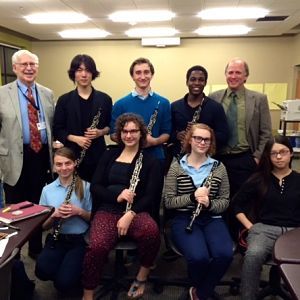
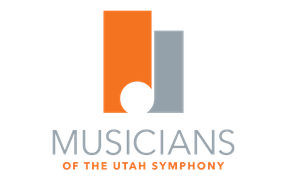
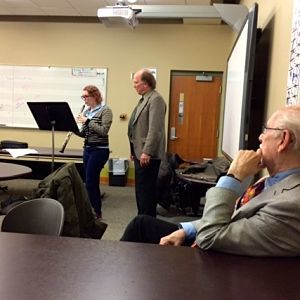
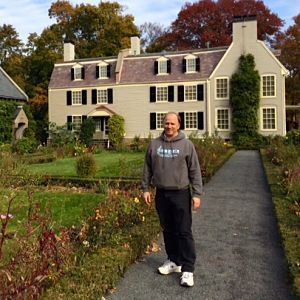
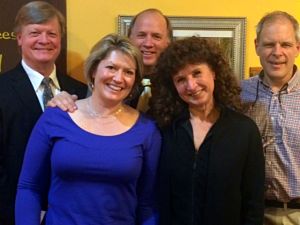
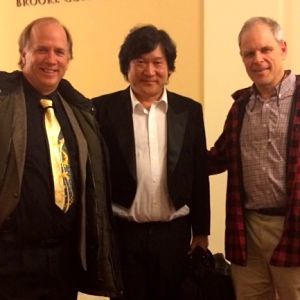
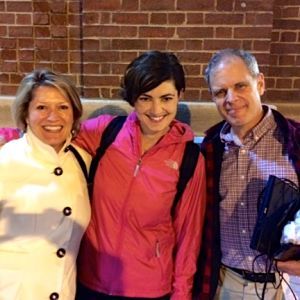
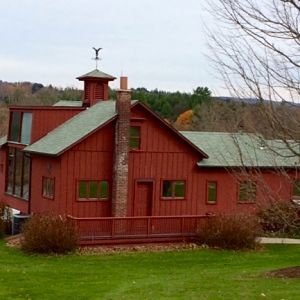




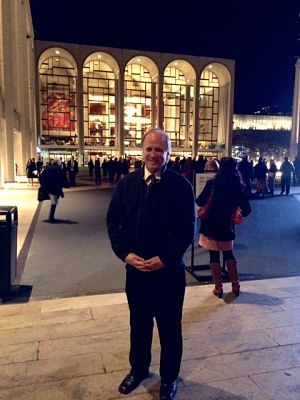

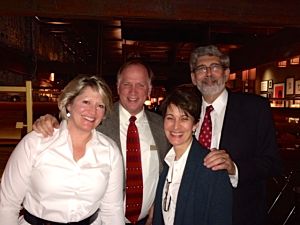
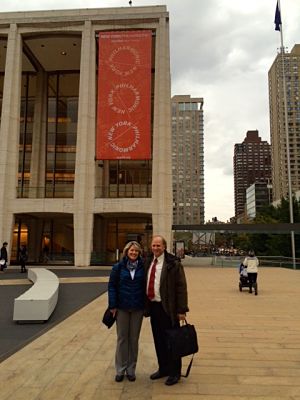
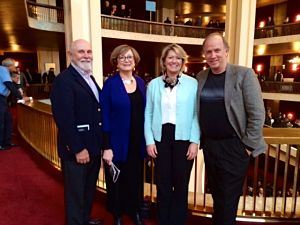
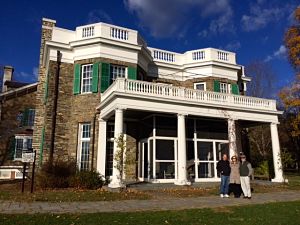
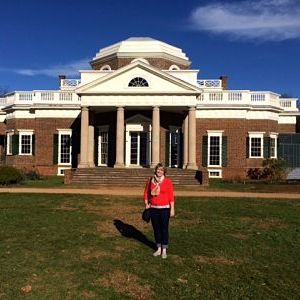
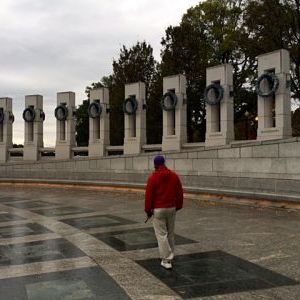

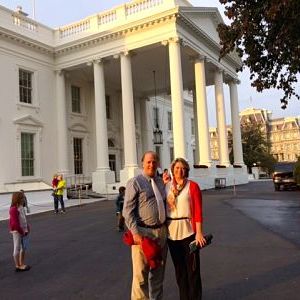
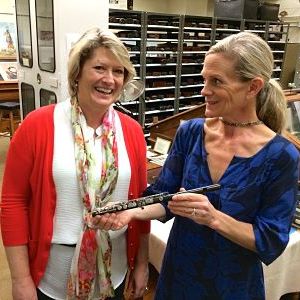









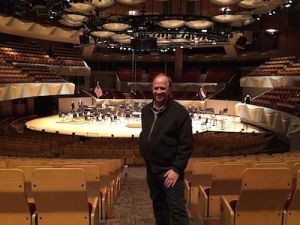


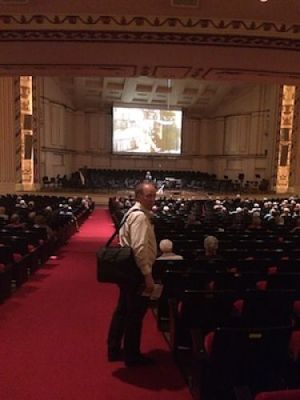
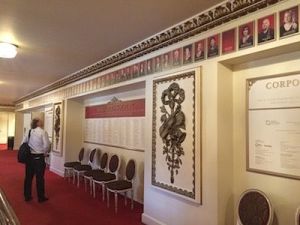
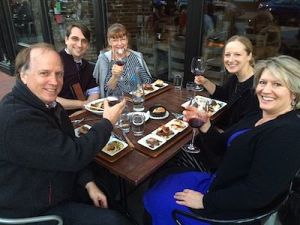
 “Wow, you’ve got the best job in the world! I mean, how hard it can be to play the triangle?” Oh no you didn’t.
“Wow, you’ve got the best job in the world! I mean, how hard it can be to play the triangle?” Oh no you didn’t.